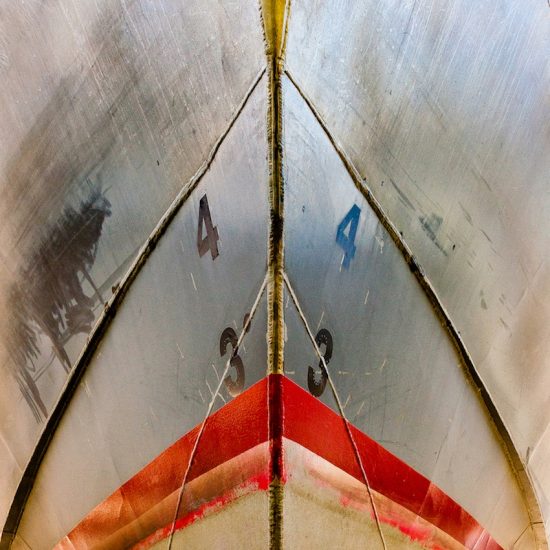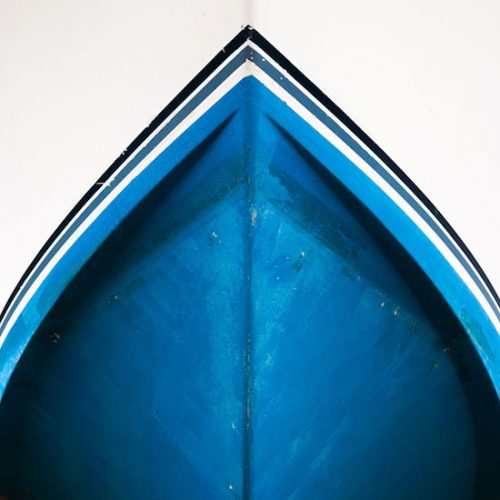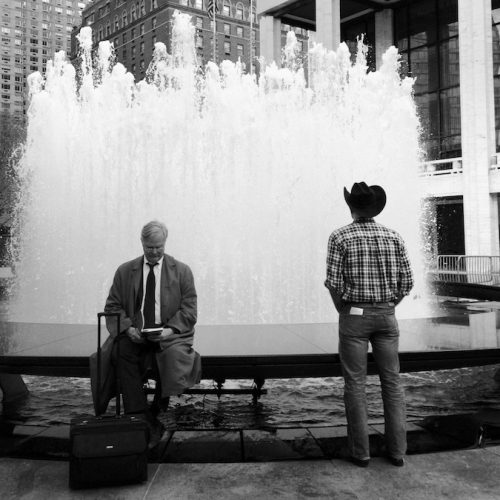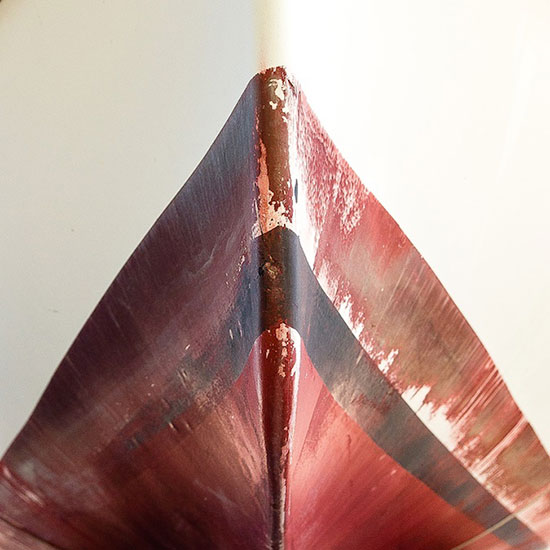Michele Dragonetti didn’t always find boat hulls beautiful. Her photographer’s eye was first drawn to street photography and capturing architectural gems, with each genre providing its own brand of visual drama. One day, while scouting for subjects, Dragonetti wandered into a boat yard in Montauk and began photographing the scenes she discovered. Drawn by the clean lines of the boats in dry dock, she captured a variety of angles in her typical fashion. By the time she was through, Dragonetti had discovered the beginnings of a new direction for her work: the front of weathered boat hulls that are abstracted to reveal their unique character.
In Dragonetti's hands, the boat hulls are an exploration resulting in abstraction that borrows from portraiture, street photography and en plein air painting. What started as a chance encounter has evolved into a serious and singular area of interest and a distinctive signature for her art.
Michele Dragonetti’s “Boat Hull” series is currently on view at The White Room Gallery in Bridgehampton in The Hamptons. Also curated by Dragonetti, “Waterlines” features 40 photographs and includes some of her largest works to date. The show also allows viewers to witness the creative trajectory that led from some of her now-iconic photographs to recent works that place a stronger emphasis on capturing the character of her subjects. The exhibition is on view from February 24 to March 5, 2017.
Select images from the "Boat Hull" series are also on view at Ilon Art Gallery in New York City. The group show, “From the Archives” is on view through March 4, 2017 and presents photography that reveals the hidden beauty captured by the exhibiting artists and some of their hidden treasures.
.
.
Departing radically from her street and interior scenes, the “Boat Hull” series features strong geometrics and vivid colors in every image. It is this consistent combination of composition and color that makes Dragonetti’s “Boat Hull” series a strong body of work.
The photographs feature a triangle, dissected by a vertical line, that divides the square image into equal parts. Vibrant colors of various hues are another component of the work. The angular shapes and areas of pure color encourages visual exploration and allow the textures and details to rise into awareness for viewers.
Through these details, the art shifts from abstraction into portraiture, capturing seagoing vessels whose exterior surfaces are transformed by interactions with water, animal and plant life, weather and usage.
.
.
To accentuate each vessel's individuality, every art work is presented as a square. The shape also serves to steepen the angles of the triangle and provides the series with a distinctive identifiable look, said the photographer in a phone interview. The concept is an effective one—just ask any of the thousands of Instagram and Facebook fans that are familiar with Dragonetti’s work, as well as her growing number of collectors.
“There are plenty of photographers making architectural images and street photography,” said Dragonetti. “My photography, no matter how good it is, would never stand out as they’re so many great photographers working in these areas. By focusing on a distinctive look, there was a chance my photographs could stand out and become identifiable as my work.”
What’s less obvious about Dragonetti’s photographs is the art making process that’s required to create them.
The idea for the now-familiar composition was not formed instantly, she explained. During that first photo shoot at the Montauk boat yard in 2013, she was attracted to boats in dry dock in need of repair and photographed them from multiple points of view. After viewing them in her studio, she fine-tuned the composition by placing them into squares and having the boat fill the composition, she said. The images struck a chord and she decided to continue exploring the possibilities.
Having the leading edge, or stem, of the boat divide the picture plane into two equal parts connected to one of Dragonetti’s aims as a photographer: to reveal something special that’s easily overlooked during daily life.
.
.
As a street photographer, Dragonetti captured images of groups of people that reveal a relationship to their surroundings, born of happenstance. When scouting for likely locations to make images, she found herself gravitated to places possessing a unique kind of beauty that might be less traveled or commonly overlooked, she said.
In New York City, she haunted locales with water towers, industrial settings or street where architectural details formed backdrops. Especially if they could prove intriguing when capturing the decisive moment of people in mid-action, said Dragonetti.
“The images can make you pay attention in a different way and you can see people in a different light,” she said.
.
.
.

"Mulberry Street" by Michele Dragonetti. In background is street art by Tristan Eaton. Photograph. Courtesy of the artist.
.
This same philosophy can be seen in her “Boat Hull” series. Extracting the boat from its setting allows the focus to shift toward something that may not be registered by most: the beauty found in the boat’s wear and tear creating an individuality through its weathering and usage in salt waters.
When making her images, Dragonetti’s street photography background comes into play and combines with experiences familiar to painters working on location in urban settings such as Valeri Larko, Diana Horowitz and Daniel Sprick.
After securing permission to photograph in boatyards, Dragonetti works quickly so as not to disturb those working there. She frequently must jockey around objects that prevent her from making the image she wants or angle the camera to avoid backgrounds not wanted. The photographer typically finds herself crouching below the boat's bow to obtain the distinctive sharp angles needed for her “Boat Hull” series. She also photographs freehand (without a tripod) to give her flexibility, stealth and speed, again as not to create disturbances.
On site, she fields questions about her intent or can become part of the action herself.
In a London boatyard, she assisting with the moving of a boat from one section to another. In another yard, she had tea and scones with one of the workers while he relayed boat stories. She can find herself conversing with fisherman, boat owners and their friends who query about her work (and share their stories). In Portugal, she spoke with those acquainted with both historic and contemporary boats and discovered the ways the culture is woven into exteriors of the hulls. Some of these adventures are relayed through her social media efforts.
.
.
In addition, there is a connection to portraiture, said Dragonetti. By focusing on what’s distinctive about each boat while accentuating the universal among all, the series reveals both commonality and individuality. She likened her process to artists who focus on faces for their portraiture work.
“Faces are similar in that they share eyes, a nose and a mouth but that doesn’t mean each person is the same,” Dragonetti said. “We all share these features and what make each person unique is what comes across when you look at a portrait. It’s the same with the boat hulls. The similar form allows the differences to stand out.”
.
.
Adopting the same structure for each work presents a creative freedom that’s easy to tap into when making the work. Making the photographs are also a lot of fun, said Dragonetti.
“I love it,” she said. “I’m drawn to a lot of things that don’t capture people’s attention. Like water towers, ramps out of tunnels, street scenes...and boats in need of repair. There’s so many great truths out there. The photographs can make you pay attention in a different way and see beauty where you might not notice it.”
Michele Dragonetti’s work has been exhibited at the National Arts Club and Atlantic Gallery in New York City, the Hutchins Gallery at Long Island University on Long Island and The White Room Gallery, the Quogue Library Gallery, Depot Gallery, Ashawagh Hall and other venues in The Hamptons and North Fork on the East End of Long Island. Michelle Dragonetti is based in New York City and Amagansett in The Hamptons.
Click here to vsit our slideshow for more of Michele Dragonetti's photography.
_________________________________
BASIC FACTS: “Waterlines” is on view from February 24 to March 5, 2017 at The White Room Gallery, 2415 Main Street, Bridgehampton, NY 11932. The gallery is open weekends only. The solo show features photography by Michele Dragonetti from her “Boat Hull” series. www.thewhiteroom.gallery.
Artist Information can be found at her website or by following her on Instagram by clicking here.
__________________________________
Copyright 2017 Hamptons Art Hub LLC. All rights reserved.







